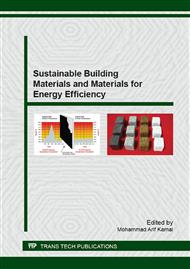[1]
Abanda, F.H., Tah J.H.M., and Cheung, F.K.T. Mathematical modeling of embodied energy, greenhouse gases, waste, time – cost parameters of building projects: A review, Building and Environment, 2012, pp.1-15.
DOI: 10.1016/j.buildenv.2012.07.014
Google Scholar
[2]
Mani, M., and Reddy, Venkataraman B.V. Sustainability in human settlements: imminent material and energy challenges for buildings in India, Journal of the Indian Institute of Science, 92, 2012, p.145–162.
Google Scholar
[3]
Jackson, T. Material Concerns: Pollution, Profit and Quality of Life. London: Routledge.
Google Scholar
[4]
Sartori I., Hestnes, A.G. Energy use in life cycle of conventional and low energy buildings , a review article, Energy and Buildings, 39 (3), 2007, pp.249-257.
DOI: 10.1016/j.enbuild.2006.07.001
Google Scholar
[5]
Tiwari Piyush. Energy Efficiency and Building Construction in India, Building and Environment, Vol. 36 (2001), pp.1127-1135.
DOI: 10.1016/s0360-1323(00)00056-1
Google Scholar
[6]
Kumar, Ashok, Chani, P.S. and Deoliya, Rajesh. Comparative assessment of energy requirements and carbon footprint for different types of materials and techniques for buildings, conference proceedings - Emerging trends of energy conservation in buildings, 2012, pp.63-71.
Google Scholar
[7]
Attman, Osman. Green Architecture: Advanced Technologies and Materials, McGraw Hill Companies, (2010).
Google Scholar
[8]
Suzuki M, Oka T. and Okada K. The estimation of energy consumption and CO2 emission due to housing construction in Japan, Energy and Buildings, 22, 1995, pp.165-169.
DOI: 10.1016/0378-7788(95)00914-j
Google Scholar
[9]
Environmental friendly India building materials & technologies for cost effective housing – A compilation. Society for Excellence in Habitat Development, Environment Protection & Employment Generation (SHEE), New Delhi.
Google Scholar
[10]
R.J. Cole, D. Rousseau. Environmental auditing for building construction: energy and air pollution indices for building materials, Building and Environment, 27, 1992, p.23–30.
DOI: 10.1016/0360-1323(92)90004-9
Google Scholar
[11]
Buchanan, A.H. Honey, B.G. Energy and carbon dioxide implications of building construction, Energy and Buildings, 20, 1994, p.205–217.
DOI: 10.1016/0378-7788(94)90024-8
Google Scholar
[12]
Debnath, Arabinda, Singh, S.V., Singh, Y.P. Comparative assessment of energy requirements for different types of residential buildings in India, Energy and Buildings, 23, 1995, pp.141-146.
DOI: 10.1016/0378-7788(95)00939-6
Google Scholar
[13]
Pullen, S.F., Data quality of embodied energy methods, proceedings of the seminar on Embodied Energy: Deakin University, Geelong, Australia, 1996, p.39–49.
Google Scholar
[14]
G. Baird, et al. The energy embodied in building materials -updated New Zealand coefficients and their significance, IPENZ Transactions 24, 1997, p.46–54.
Google Scholar
[15]
Treloar, G.J. A comprehensive embodied energy analysis framework, PhD. Thesis, Deakin University, Victoria, Australia, (1998).
Google Scholar
[16]
CSIRO. Embodied and life time energies in the built environment, 2000, http: /www. tececo. com. au.
Google Scholar
[17]
Chani, P. S. Primary energy estimation for contemporary housing in Northern India, Ph.D. Dissertation, Dept. Architecture and Planning, University of Roorkee, India, (2000).
Google Scholar
[18]
Miller, A.J., 2001. Embodied energy – a life cycle of transportation energy embodied in construction materials, in: COBRA 2001, Conference Papers, RIC Foundation.
Google Scholar
[19]
Alcorn, A. Embodied Energy and CO2Coefficients for NZ Building Materials, Centre for Building Performance Research, Victoria University of Wellington, (2003).
Google Scholar
[20]
Reddy, Venkataraman B.V., Jagdish K.S. Embodied Energy of Common and Alterative Building Technologies, Energy and Buildings, Vol. 35, 2003, pp.129-137.
DOI: 10.1016/s0378-7788(01)00141-4
Google Scholar
[21]
R.H. Crawford, G.J. Treloar. Assessment of embodied energy analysis methods for Australian construction industry, in: The 38th International Conference of Architectural Science Association ANZAScA, Tasmania, (2004).
Google Scholar
[22]
Menzies, G.F., Turan, S., Banfill, P.F.G. Life-cycle assessment and embodied energy: a review. Construction Materials, 160, 2007, pp.135-143.
DOI: 10.1680/coma.2007.160.4.135
Google Scholar
[23]
Hammond, G., Jones, C. Embodied energy and carbon in construction materials, Energy, 161 (2), 2008, pp.87-98.
Google Scholar
[24]
Dixit, Manish Kumar, Fernández-Solís, José L., Lavy, Sarel, Culp, Charles H. Identification of parameters for embodied energy measurement: A literature review, Energy and Buildings, Vol. 42(8), 2010, p.1238–1247.
DOI: 10.1016/j.enbuild.2010.02.016
Google Scholar
[25]
Praseeda, K.I., Reddy, B.V. Venkatarama, Manic, Monto. Embodied energy assessment of building materials in India using process and input–output analysis, Energy and Buildings, Vol. 86, 2015, p.677–686.
DOI: 10.1016/j.enbuild.2014.10.042
Google Scholar
[26]
Chani P.S., Kaushik S.K. Estimation and reduction of primary energy in housing construction. Seminar proceedings on Approach to Planning in 2000 and Beyond, 2000, pp.49-73.
Google Scholar
[27]
Rai, Mohan. Energy conservation in production of building materials, Energy and Habitat, Ed. Vinod Gupta, Wiley Eastern Ltd., New Delhi, 1984, pp.63-65.
Google Scholar
[28]
IS – 13757. Burnt clay flyash bricks, Bureau of Indian Standards, New Delhi, (1993).
Google Scholar
[29]
IS – 13990. Precast RC planks and joists for floors and roofs, Bureau of Indian Standards, New Delhi, (1994).
Google Scholar
[30]
IS – 14142. Design and construction of floors / roofs with prefabricated Brick Panels, Bureau of Indian Standards, New Delhi, (1994).
Google Scholar
[31]
IS – 14143. Prefabricated brick panels and joists for floors and roofs, Bureau of Indian Standards, New Delhi, (1994).
Google Scholar
[32]
IS – 2572. Precast cement concrete (hollow and solid) blocks, Bureau of Indian Standards, New Delhi, (2005).
Google Scholar
[33]
IS – 12984. Sand lime bricks, Bureau of Indian Standards, New Delhi, (1990).
Google Scholar
[34]
Kumar, Ashok. Research project report on Development of a framework to reduce the carbon footprint and enhance the energy efficiency in buildings, CSIR- Central Building Research Institute, Roorkee, 2012, www. cbri. res. in.
Google Scholar
[35]
Kumar, Ashok, Deoliya, Rajesh, Chani, P.S. Insulating Materials for Energy Saving in Buildings, Trans Tech Publications, Switzerland, under Key Engineering Materials, doi: 10. 4028, Vol. 632, 2015, pp.1-14.
DOI: 10.4028/www.scientific.net/kem.632.1
Google Scholar


